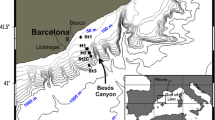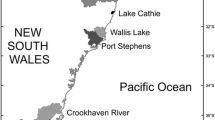Abstract
Sediment cores from the upper continental slope of the eastern Arabian Sea have high organic carbon (OC), CaCO3, and sand content at the top. The values decrease with increasing depth in the Holocene and Upper Pleistocene. Topographic highs show highest OC and lower CaCO3 in the Holocene clayey sediments and vice versa in the Pleistocene sandy sediments. The OC is immature and marine or a mixture of both marine and terrestrial in the Holocene sediments and is mostly terrestrial and/or reworked marine in the Pleistocene sediments. Productivity is the main controlling factor for the organic carbon enrichment. Texture and reworking also influence the organic carbon variations.
Similar content being viewed by others
Author information
Authors and Affiliations
Additional information
Received: 29 May 1996/Revision received: 10 January 1997
Rights and permissions
About this article
Cite this article
Thamban, M., Rao, V. & Raju, S. Controls on organic carbon distribution in sediments from the eastern Arabian Sea Margin. Geo-Marine Letters 17, 220–227 (1997). https://doi.org/10.1007/s003670050030
Issue Date:
DOI: https://doi.org/10.1007/s003670050030




